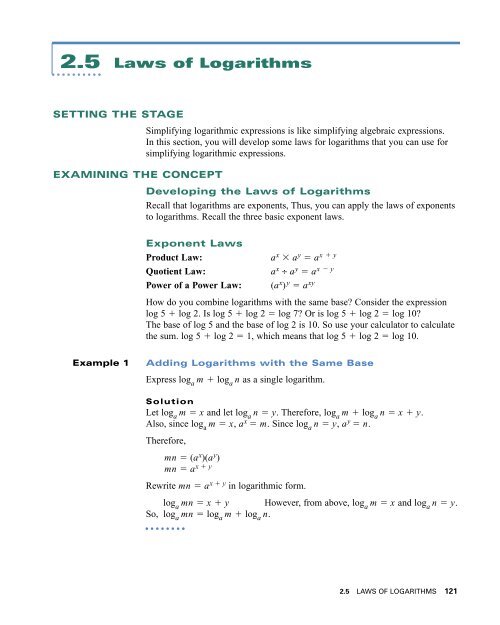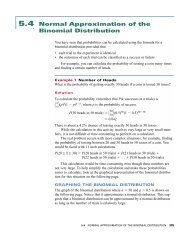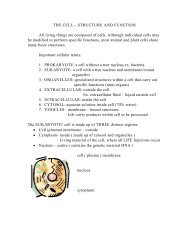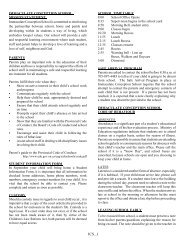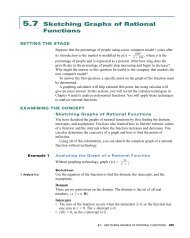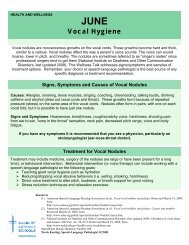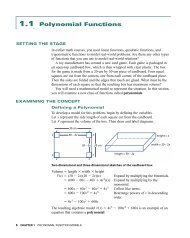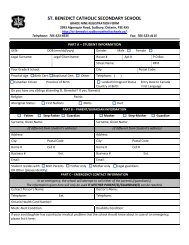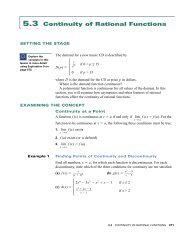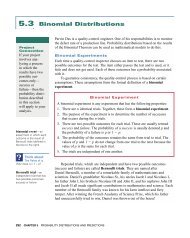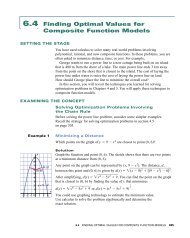2.5 Laws of Logarithms
2.5 Laws of Logarithms
2.5 Laws of Logarithms
Create successful ePaper yourself
Turn your PDF publications into a flip-book with our unique Google optimized e-Paper software.
<strong>2.5</strong> <strong>Laws</strong> <strong>of</strong> <strong>Logarithms</strong><br />
SETTING THE STAGE<br />
Simplifying logarithmic expressions is like simplifying algebraic expressions.<br />
In this section, you will develop some laws for logarithms that you can use for<br />
simplifying logarithmic expressions.<br />
EXAMINING THE CONCEPT<br />
Developing the <strong>Laws</strong> <strong>of</strong> <strong>Logarithms</strong><br />
Recall that logarithms are exponents, Thus, you can apply the laws <strong>of</strong> exponents<br />
to logarithms. Recall the three basic exponent laws.<br />
Exponent <strong>Laws</strong><br />
Product Law:<br />
Quotient Law:<br />
Power <strong>of</strong> a Power Law:<br />
a x a y a x y<br />
a x ÷ a y a x y<br />
(a x ) y a xy<br />
How do you combine logarithms with the same base Consider the expression<br />
log 5 log 2. Is log 5 log 2 log 7 Or is log 5 log 2 log 10<br />
The base <strong>of</strong> log 5 and the base <strong>of</strong> log 2 is 10. So use your calculator to calculate<br />
the sum. log 5 log 2 1, which means that log 5 log 2 log 10.<br />
Example 1<br />
Adding <strong>Logarithms</strong> with the Same Base<br />
Express log a<br />
m log a<br />
n as a single logarithm.<br />
Solution<br />
Let log a<br />
m x and let log a<br />
n y. Therefore, log a<br />
m log a<br />
n x y.<br />
Also, since log a<br />
m x, a x m. Since log a<br />
n y, a y n.<br />
Therefore,<br />
mn (a x )(a y )<br />
mn a x y<br />
Rewrite mn a x y in logarithmic form.<br />
log a<br />
mn x y However, from above, log a<br />
m x and log a<br />
n y.<br />
So, log a<br />
mn log a<br />
m log a<br />
n.<br />
<strong>2.5</strong> LAWS OF LOGARITHMS 121
Law for <strong>Logarithms</strong> <strong>of</strong> Products<br />
log a<br />
mn log a<br />
m log a<br />
n<br />
The log <strong>of</strong> a product <strong>of</strong> factors equals the sum <strong>of</strong> the logs <strong>of</strong> the factors.<br />
Use the law <strong>of</strong> logarithms <strong>of</strong> products to evaluate log 6<br />
4 log 6<br />
9.<br />
log 6<br />
4 log 6<br />
9 log 6<br />
(4)(9) Simplify.<br />
log 6<br />
36 Evaluate.<br />
2<br />
Now find the difference between logs with the same base.<br />
Example 2<br />
Subtracting <strong>Logarithms</strong> with the Same Base<br />
Express log a<br />
m log a<br />
n as a single logarithm.<br />
Solution<br />
Let log a<br />
m x and let log a<br />
n y. Therefore, log a<br />
m log a<br />
n x y.<br />
Also, since log a<br />
m x, a x m. Since log a<br />
n y, a y n.<br />
Therefore,<br />
m n <br />
a x<br />
a<br />
y<br />
m n ax y<br />
Rewrite m n ax y in logarithmic form.<br />
log a m n x y However, from above, log a m x and log a n y.<br />
So log a m n log a m log a n.<br />
Law for <strong>Logarithms</strong> <strong>of</strong> Quotients<br />
log a m n log a m log a n, n ≠ 0<br />
The log <strong>of</strong> a quotient equals the log <strong>of</strong> the dividend less the log <strong>of</strong> the<br />
divisor.<br />
Use the law for logarithms <strong>of</strong> quotients to simplify log 2<br />
18 log 2<br />
9.<br />
log 2<br />
18 log 2<br />
9 log 2 1 8<br />
9 Simplify.<br />
log 2<br />
2<br />
1<br />
Evaluate.<br />
122 CHAPTER 2 EXPONENTIAL AND LOGARITHMIC FUNCTION MODELS
Example 3<br />
Finding the Logarithm <strong>of</strong> a Power<br />
What is the value <strong>of</strong> log 3<br />
9 2 <br />
Solution<br />
log 3<br />
9 2 log 3<br />
81<br />
4<br />
Another solution is to use the law for logarithms <strong>of</strong> products.<br />
log 3<br />
9 2 log 3<br />
(9)(9)<br />
log 3<br />
9 log 3<br />
9<br />
2 log 3<br />
9<br />
2(2)<br />
4<br />
Apply the law for logarithms <strong>of</strong> products.<br />
Simplify.<br />
Evaluate.<br />
In general, if p ∈ N and using the law for logarithms <strong>of</strong> products,<br />
log a<br />
m p log a<br />
m log a<br />
m log a<br />
m … log a<br />
m<br />
p log a<br />
m<br />
p times<br />
⎫ ⎪⎪⎪⎪⎪⎪⎪⎪⎪⎪⎪⎬⎪⎪⎪⎪⎪⎪⎪⎪⎪⎪⎪⎭<br />
Law for <strong>Logarithms</strong> <strong>of</strong> Powers<br />
log a<br />
m p p log a<br />
m (m > 0, p ∈ R)<br />
The log <strong>of</strong> a power equals the exponent <strong>of</strong> the power times the log <strong>of</strong> the<br />
base <strong>of</strong> the power.<br />
Now evaluate 2 log 10<br />
2 2 log 10<br />
5.<br />
2 log 10<br />
2 2 log 10<br />
5 log 10<br />
2 2 log 10<br />
5 2 Use the law for logarithms<br />
<strong>of</strong> powers.<br />
log 10<br />
(4)(25) Use the law for logarithms<br />
<strong>of</strong> products.<br />
log 10<br />
100<br />
Evaluate.<br />
2<br />
Example 4<br />
Evaluating the Logarithm <strong>of</strong> a Power<br />
Evaluate log 2<br />
8.<br />
Solution<br />
log 2<br />
8 log 2<br />
(8)<br />
Apply the law for logarithms <strong>of</strong> powers.<br />
1 2 log 2<br />
8 Evaluate and simplify.<br />
1 2 (3)<br />
3 2 <br />
1 2<br />
<strong>2.5</strong> LAWS OF LOGARITHMS 123
It is <strong>of</strong>ten necessary to use the laws <strong>of</strong> logarithms to solve logarithmic equations.<br />
Example 5<br />
Solving a Logarithmic Equation<br />
Solve for x in log 3<br />
x 1 2 log 3 36 log 3 18 log 3 2.<br />
Solution<br />
Express the right side as a single logarithm with base 3.<br />
log 3<br />
x 1 2 log 3 36 log 3 18 log 3<br />
2 Use the law for logarithms <strong>of</strong> powers.<br />
1<br />
2<br />
log 3<br />
x log 3<br />
(36) log 3<br />
18 log 3<br />
2 Simplify.<br />
log 3<br />
x log 3<br />
6 log 3<br />
18 log 3<br />
2 Use the law for logarithms <strong>of</strong><br />
products.<br />
log 3<br />
x log 3<br />
(6)(18) log 3<br />
2 Use the law for logarithms <strong>of</strong><br />
quotients.<br />
log 3<br />
x log 3<br />
(6)( 18)<br />
<br />
Simplify.<br />
2<br />
log 3<br />
x log 3<br />
54<br />
∴ x 54<br />
Equivalent <strong>Logarithms</strong><br />
If log a<br />
m log a<br />
n, then m n, provided a > 0, and a ≠ 1.<br />
This result is true only when the logarithms have the same base.<br />
CHECK, CONSOLIDATE, COMMUNICATE<br />
1. Evaluate log 8<br />
16 log 8<br />
4.<br />
2. Evaluate log 2000 log 2.<br />
3. Express 2 log 3<br />
5 3 log 3<br />
2 as a single logarithm.<br />
4. Give an example to show that the law for logarithms <strong>of</strong> powers works.<br />
KEY IDEAS<br />
• If m and n are positive numbers, a is a positive number other than 1,<br />
and p is any real number, then the following laws hold true:<br />
Law for <strong>Logarithms</strong> <strong>of</strong> Products: log a<br />
(mn) log a<br />
m log a<br />
n<br />
Law for <strong>Logarithms</strong> <strong>of</strong> Quotients: log a m n log a m log a n, n ≠ 0<br />
Law for <strong>Logarithms</strong> <strong>of</strong> Powers: log a<br />
m p p log a<br />
m<br />
• If log a<br />
m log a<br />
n, then m n, provided a > 0, and a ≠ 1.<br />
124 CHAPTER 2 EXPONENTIAL AND LOGARITHMIC FUNCTION MODELS
<strong>2.5</strong> Exercises<br />
A<br />
1. Evaluate each expression by first using the laws <strong>of</strong> logarithms.<br />
(a) log 2<br />
320 log 2<br />
20 (b) log 2<br />
144 log 2<br />
9<br />
(c) log 6<br />
4 log 6<br />
9 (d) log 4 log 25<br />
(e) log 8<br />
16 log 8<br />
32 (f) log 3<br />
27 log 3<br />
9<br />
2. Use the laws <strong>of</strong> logarithms to expand each expression.<br />
(a) log 2<br />
(14 9) (b) log 5 7 35<br />
<br />
40<br />
<br />
1<br />
2<br />
(c) log 7<br />
(25) (d) log 6<br />
(9 8 7)<br />
(e) log 3<br />
(15) 4 (f) log 4 8 1<br />
30 <br />
3. Evaluate each expression without using a calculator.<br />
(a) log 25 log 4 (b) log 3<br />
18 log 3<br />
6<br />
(c) log 2<br />
8 3<br />
(d) log 3<br />
9<br />
(e) log 6<br />
3 log 6<br />
12 (f) 2 log 5<br />
15 log 5<br />
9<br />
(g) log 4<br />
32 log 4<br />
2 (h) log 2<br />
(32) 4<br />
4. Evaluate, using the law for logarithms <strong>of</strong> powers.<br />
(a) log 3<br />
3 9 (b) log 3<br />
4 27<br />
(c) log 6<br />
3 36 (d) log 5<br />
125 <br />
(e) log 8<br />
3 64 (f) log 4 1<br />
1<br />
<br />
6 <br />
5. Knowledge and Understanding: Evaluate and then state the logarithmic law<br />
that you used.<br />
(a) log 8<br />
6 log 8<br />
3 log 8<br />
2 (b) log 2<br />
3 32<br />
(c) log 3<br />
54 log 3 3 2 (d) log 5<br />
5 125 <br />
(e) log 8<br />
2 3 log 8<br />
2 1 2 log 8 16 (f) log 2 1 8 <br />
6. Express each expression as a single logarithm.<br />
(a) 3 log 5<br />
2 log 5<br />
7 (b) 2 log 3<br />
8 5 log 3<br />
2<br />
(c) 2 log 2<br />
3 log 2<br />
5 (d) log 3<br />
12 log 3<br />
2 log 3<br />
6<br />
(e) log 4<br />
3 1 2 log 4 8 log 4<br />
2 (f) 2 log 8 log 9 log 36<br />
<strong>2.5</strong> LAWS OF LOGARITHMS 125
B<br />
7. Evaluate log 2<br />
(8)(32) log 7<br />
(49)( 4 7).<br />
8. Given x log 2<br />
5 and y log 2<br />
3, evaluate each expression in terms <strong>of</strong> x<br />
and y.<br />
(a) log 2<br />
15 (b) log 2<br />
0.6 (c) log 2<br />
125<br />
9. Solve for x.<br />
(a) log 2<br />
x log 2<br />
5 log 2<br />
10<br />
(b) log 3<br />
x log 3<br />
18 log 3<br />
3<br />
(c) log x log 84 log 5 log 7<br />
(d) log x 2 log 4 3 log 3<br />
(e) log 5<br />
x log 5<br />
8 log 5<br />
6 3 log 5<br />
2<br />
10. Express as a single logarithm. Assume all variables are positive.<br />
(a) log 2<br />
x log 2<br />
y log 2<br />
z (b) log 5<br />
u log 5<br />
v log 5<br />
w<br />
(c) log 6<br />
a (log 6<br />
b log 6<br />
c) (d) log 2<br />
x 2 log 2<br />
xy log 2<br />
y 2<br />
(e) 1 log 3<br />
x 2<br />
11. If log 3<br />
x 0.2, find the value <strong>of</strong> log 3<br />
xx.<br />
(f) 3 log 4<br />
x 2 log 4<br />
x log 4<br />
y<br />
12. If log a<br />
w 1 2 log a x log a<br />
y, express w in terms <strong>of</strong> x and y.<br />
13. Communication: Explain the similarities between the laws <strong>of</strong> exponents and<br />
the laws <strong>of</strong> logarithms.<br />
14. Use a calculator to evaluate each expression to two decimal places.<br />
(a) log 4 8 (b) log 40 (c) log 9 4<br />
(d) log 200 log 50 (e) (log 20) 2 (f) 5 log 5<br />
15. Application: The loudness, L, <strong>of</strong> a sound is related to the sound’s intensity,<br />
I<br />
I, by L 10 log I<br />
, where L is measured in decibels, I is measured in<br />
0<br />
watts per square metre, and I 0<br />
is the intensity <strong>of</strong> a barely audible sound.<br />
By how many decibels does the loudness increase if the intensity <strong>of</strong> the<br />
sound from a tuning fork is tripled<br />
16. A barely audible sound has an intensity <strong>of</strong> I 0<br />
10 12 W/m 2 .<br />
Use the formula in question 15 to calculate the loudness <strong>of</strong> each sound.<br />
(a) a falling pin: I 10 11 W/m 2<br />
(b) quiet conversation: I 10 6 W/m 2<br />
(c) subway: I 10 3 W/m 2<br />
(d) jet at take-<strong>of</strong>f: I 1 W/m 2<br />
126 CHAPTER 2 EXPONENTIAL AND LOGARITHMIC FUNCTION MODELS
C<br />
17. Check Your Understanding: Give an example to show the usefulness <strong>of</strong> one<br />
<strong>of</strong> the laws <strong>of</strong> logarithms in evaluating an expression.<br />
18. Thinking, Inquiry, Problem Solving: Use graphing technology to draw<br />
graphs <strong>of</strong><br />
(a) y log x log 2x (b) y log 2x 2<br />
You will notice that the graphs are different. Yet simplifying the first<br />
expression using the laws <strong>of</strong> logarithms produces the second expression.<br />
Explain why the graphs are different.<br />
19. Create two logarithmic functions using different expressions. The functions<br />
should have the same graph. Demonstrate why the graphs are the same.<br />
20. Create expressions to show each logarithm law.<br />
ADDITIONAL ACHIEVEMENT CHART QUESTIONS<br />
Knowledge and Understanding: Use the logarithm laws to write each expression<br />
as a single logarithm. Then evaluate.<br />
(a) 2 log 3<br />
6 log 3<br />
18 log 3<br />
24 (b) log 4<br />
32 log 4<br />
8<br />
Application: A rock is classified according to its diameter. A granule has a<br />
1<br />
diameter <strong>of</strong> 2 mm. A particle <strong>of</strong> sand has a diameter <strong>of</strong> 1<br />
mm. How are the logs<br />
6<br />
<strong>of</strong> the two values related<br />
Thinking, Inquiry, Problem Solving: Given log 3<br />
5 x and log 3<br />
2 y, write<br />
log 3 1 2<br />
5 in terms <strong>of</strong> x and y.<br />
Communication: Here is Eldon’s solution to a problem. Identify Eldon’s<br />
mistakes. Explain how Eldon made the mistakes, and correct the solution.<br />
log 2<br />
16 as a single logarithm.<br />
Express 2 log 2<br />
5 log 2 4 5 1 2 <br />
2 log 2<br />
5 log 2 4 5 1 2 log 16 log 2 52 log 2 4 5 log 2 1 6<br />
2 <br />
log 2<br />
25 log 2 4 5 log 2<br />
8<br />
log 2 25 4 5 <br />
8 <br />
<strong>2.5</strong> LAWS OF LOGARITHMS 127


